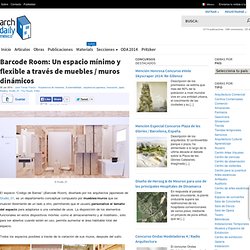

Mid-century grain silo transformed into a gorgeous, affordable home for two. Kaiser purchased the dismantled 1955 grain silo online from a Kansas farmer that was then transported down to Arizona on the back of a pickup truck.

Major modifications were made during the reassembly process for the silo, such as the addition of custom-made doors and windows, as well as the ten inches of spray foam insulation inserted between the silo walls and house interior. The corrugated steel shell was painted white to reflect the heat of the desert sun and to evoke the character of historic American rural architecture. Related: COBE Transforms Old Industrial Silo Into High-Rise Housing in Copenhagen. PATH Architecture. Elii Architects Equip Tiny Madrid Studio with a Host of Quirky Space Saving Features. The owner of the studio, Dido Fogué, worked with the design team to not only achieve the optimal amount of useable space in her little Spanish haven, (nicknamed the Didomestic Home) but to do so in her unique style, which she describes as “a heavy metal fan that is very fond of Hello Kitty.”

Elii Studio, the Madrid-based architecture and urban design specialists, began the project from a theatrical point of view. The home renovation focused on creating many quick “scene changes” as necessary depending on the circumstances. For optimal interior living space, the designers added a series of lightweight partitions that roll on rails. This creates the ability to add an extra, private bedroom for guests, as well as separate the kitchen and dining room. For interior lighting, the opaque panels on the partitions let natural light pass through the studio whether the partitions are open or closed. + Elii Architects. Apparatus X: Sustainable Disaster Relief Vehicle. After Hurricane Katrina devastated New Orleans’ Lower 9th Ward, one resident called the destruction indescribable – even compared with his experience as a Vietnam War veteran.

Although the Katrina survivor wants to come home, he says "there’s nothing to come back to.” Katrina displaced thousands of people and ruined billions of dollars of property. Although more than eight years have passed, the Lower 9th Ward is still struggling to rebuild its community. Out of 14,000 people, only 3,000 have returned; properties are still vacant, and the remains of houses speckle the landscape. Clearly, there exists an entire population of displaced Americans, and our institutions have failed them. Rustic Off-Grid Pump House is a Solar-Powered Weekend Getaway in Australia. A Master Architect Builds a Tiny Cabin in the Pacific Northwest. Older A Master Architect Builds a Tiny Cabin in the Pacific Northwest by Meredith Swinehart Issue 31 · Cabins & Camping · August 1, 2012 Newer.

A Tiny House in Martha Stewart Living. Small House Swoon. Small House Swoon. Port-A-Bach Shipping Container Home. Atelierworkshop designed the Port-a-Bach prototype shipping container home which is portable, environmentally-friendly, inexpensive, and can comfortably sleep two adults and two children.

The tiny home features exterior steel shell that can be folded up to enclose the entire structure. There are large internal storage cupboards and shelves, a stainless steel kitchen, bathroom with open shower, sink and composting toilet. An interior fabric screen system allows you to create rooms within the open space. Fittings allow the use of the container connections to attach to solar and wind equipment. Via: Atelierworkshop Comments. The Tiny Tack House, of the Tiny House Movement. Ecohome | Hillary Hosta | Posted on Sunday, July 1, 2012 - 3:10pm Inspired by the Tiny House Movement, Chris and Malissa Tack designed a 140 Square foot home that sits on a 7’ x 20’ trailer bed.

This traditional looking home with gable roof and dormers just happens to be mobile. Though neither Chris nor Malissa are builders by trade (he's a photographer and she's a 3D artist), the Tiny Tack House took just seven months to finish. Malissa, whose profession helped them greatly during the design process, characterizes the experience as a really good time saying "...we had a blast the whole way through".
After tirelessly researching each stage of building, the couple finally began to design. Tiny House Swoon. Ufogel, una casa compacta de madera. Construida totalmente de madera de Alerce y levantada sobre pilotes que reducen al mínimo el impacto ambiental de la construcción, la casa Ufogel -que toma su nombre de su parecido con un Ovni (Ufo) y un Vogel (“Pájaro” en alemán)-, se configura a través de un compacto interior de 45 m2, que se amplía a través de diferentes niveles interconectados, generando cómodos y luminosos espacios para la vida de sus habitantes.

Revisa más información e imágenes a continuación. La casa se ubica en Tirol del Este, en Austria y ocupa la madera como material principal por su abundancia en la zona. Un Departamento de 16 m2 en Seattle. El mini-departamento de Steve Sauer en Seattle muestra el valor del espacio justo.

A Sauer le gusta esta precisión… los espacios excesivos y desperdiciados le molestan. “Lo que realmente quería era un espacio que cumpliera exactamente con lo que yo necesitaba. Para mí, la calidad es más importante que la cantidad y el espacio adicional es sólo un problema”, comenta al describir su departamento de una sola habitación. Barcode Room. El espacio “Código de Barras” (Barcode Room), diseñado por los arquitectos japoneses de Studio_01, es un departamento conceptual compuesto por muebles/muros que se mueven libremente de un lado a otro, permitiendo que el usuario personalice el tamaño del espacio para adaptarse a una variedad de usos.

La disposición de los elementos funcionales en estos dispositivos móviles -como el almacenamiento y el mobiliario-, sólo para ser abiertos cuando estén en uso, permite aumentar el área habitable total del espacio. Portable home delivered as furniture, tailored as smartphone. The year in small: A world tour of 13 tiny houses we loved in '13. From Maryland, pint-sized rustic retreats that are custom-built from recycled and locally-sourced materials and that “speak to the art of the small building movement. "